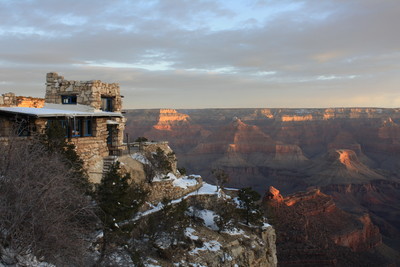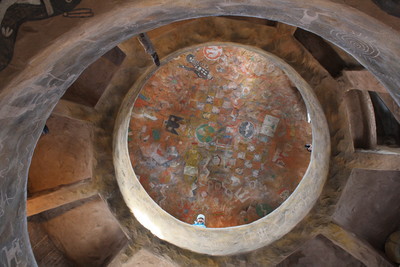Grand Canyon’s South Rim inspired unforgettable architecture
For millions of people around the world, a trip to the Grand Canyon is a lifelong dream, fulfilled at great expense in money and time. But for those of us in Southern Nevada, it's only a half-day's drive, so the trip needn't drain the bank account.
Nearby Nevadans can therefore afford multiple visits, each specializing in one or two of the canyon's many aspects. So on the most recent of many trips my daughters and I have made there, besides the hiking and overlook-gazing we consider mandatory every visit, we concentrated on the South Rim's charming, historic buildings.
Grand Canyon National Park was established in 1919, but interest in the place exploded years earlier. In 1901, when the Atchison, Topeka & Santa Fe Railroad built a 65-mile spur from its main line to the canyon, travel there became civilized. Earlier visitors had to get off the train in Flagstaff and endure a jolting stagecoach ride of 20 hours and 80 miles.
Early tourist accommodations were equally primitive, but El Tovar Hotel fixed that. Commissioned by the Santa Fe, it opened in 1905 and was considered one of the most luxurious hotels west of the Mississippi. The hotel still serves as the most deluxe accommodation in the park and was the choice for U.S. presidents, including Theodore Roosevelt, Herbert Hoover, George H.W. Bush, Dwight Eisenhower and Bill Clinton.
El Tovar was managed by the Fred Harvey Company, which was well-established in the travel business. When the company's namesake and founder first headed west, he witnessed first-hand the intolerable travel conditions and set out to change them. Working with railroads, he opened restaurants, hotels and retail stores to provide quality service, food and lodging. In the 1880s and 1890s, Harvey Houses were located every 100 miles along the Santa Fe Railroad from Kansas to California. Perhaps their best-known virtues were his "Harvey Girls" -- pretty, intelligent and well-trained waitresses hired from the East.
Harvey died in 1901, but his sons ran the business through the 1930s. When they wanted more tourist-friendly structures along the rim, they hired architect Mary Elizabeth Jane Colter. Back then, a woman was a rarity in the architecture field. Although she was born in the East, Colter's designs were greatly influenced by the people, culture and landscapes of the Southwest. She made her buildings fit into the natural environment; even when only weeks old, they looked as if they had been there, well-kept, for centuries.
By the end of our three-day trip, we had visited all the Colter-designed buildings still standing along the rim, all of which are listed on the National Register of Historic Places: The Bright Angel Lodge, Lookout Studio, Hopi House, Hermit's Rest and the Desert View Watchtower.
We were staying in a cabin at Bright Angel Lodge, designed in 1935, in the historic Grand Canyon Village. One unique example of Colter's work is a 10-foot-high stone fireplace found in the lodge's lobby. The rocks in the fireplace re-create the geological strata of the canyon itself; the lower ones are round river boulders, and the top ones Kaibab limestone. Every stone was carefully picked and packed to the site on muleback.
The Bright Angel Lodge's location can't be beat, unless you have a sleepwalker in your group, as the property lies just yards from the rim. Our cabin wasn't roomy, about the size of a small motel room, but it had plenty of windows and all the usual conveniences. After unpacking a few things, we headed out to begin exploring.
There was about a foot of snow in places, but we were determined to hike and tried a short segment of the Bright Angel Trail. This is one of the most popular routes, not only for walkers tackling just a day hike's worth, but also for extended trips to the inner canyon and the Colorado River. It also serves as a mule-ride route.
The upper end of the trail had plenty of snow and ice, which made for treacherous travel near drop-offs measured in hundreds of feet. We donned lightweight crampons, which really helped grip the snow.
One interesting feature of this trail was only about 800 or so feet into our hike, just after a man-made tunnel cut through the rock. Here, high on a cliff face, within a shallow alcove known as Mallery's Grotto, we saw red pictographs. These images span centuries, and some are thought to have been created by ancestors of the Havasupai Indians, who today live in the western Grand Canyon. Since we hadn't brought binoculars, it was hard to make out all the figures, but we could easily recognize many depictions of elk. Prehistoric hunters and gatherers used this trail long before it was discovered by 19th century miners or modern backpackers.
But a mile of it was all we cared to do this day, as elevation gain makes the return trip strenuous. A good rule of thumb when hiking the trail is, however long it takes you to descend, allow twice that time for your return. Good day-hiking choices are the turnaround destinations called Mile-and-a-Half Resthouse, Three-Mile Resthouse and Indian Garden Resthouse, the last about 4.6 miles down the trail.
Back at the rim, we checked out the multi-level Kolb Studio, built in 1904 by brothers Emery and Ellsworth Kolb for photography. Located directly at the Bright Angel Trailhead, they photographed tourists embarking on mule trips. Since quality water wasn't available on the rim to develop their film, they had to hike down the Bright Angel Trail 4.5 miles to Indian Garden, a 3,060-foot, one-way descent. Here, they would develop the film and then head back up to the rim, often arriving in the nick of time to greet the mule train carrying their paying customers. The building now serves as a gift shop, book store and exhibit hall.
Nearby, we found the oldest structure on the rim, a cabin built in the 1890s and now incorporated into the Bright Angel Lodge. Its builder was William Owen "Bucky" O'Neill, Arizona's all-around guy -- author, miner, politician and judge. Volunteering to fight during the Spanish-American War, O'Neill served with Theodore Roosevelt's Rough Riders in Cuba, where he was killed by sniper fire in 1898.
The Colorado River has an elevation of only 2,400 feet at this point, but its canyon's South Rim rises to about 7,000, and is 20 to 30 degrees colder. The South Rim remains cool through spring, and it isn't uncommon for snow to fall into May. During April, the average daily temperature is 60, with the low at 32 degrees.
On our second morning, we drove east about 25 miles along the rim, all within the park's boundaries, to the Watchtower at Desert View. We found this to be one of Colter's most creative buildings. Opened in 1933, the 70-foot tower was patterned after Ancestral Puebloan watchtowers found in the Four Corners region. At 7,522 feet, the tower is the highest place on the South Rim. It affords 360-degree views, taking in not only the canyon and the Colorado River, but the Painted Desert, the San Francisco Peaks outside of Flagstaff and Navajo Mountain, 90 miles north in Utah.
We headed up the narrow stone stairs to the first level called the Hopi Room. Its murals were painted by Hopi artist Fred Kabotie and depict important themes such as the Snake Legend, God of the Clouds and the Course of the Sun. The wall and ceiling decorations in the first and second galleries are copied from drawings and rock art found around the Southwest.
That afternoon, we walked less than one half mile along the Rim Trail from our cabin to the Hopi House. Completed on New Year's Day in 1905, just two weeks before the opening of El Tovar, it was built to sell Indian arts and crafts. Colter patterned it after traditional structures of the Oraibi village on the Hopi Reservation. The three-story stone-and-adobe building was constructed by Hopi craftsman and to this day offers top-notch Native American pottery, rugs and jewelry and a gallery featuring traditional and contemporary art. Just across the way was El Tovar Hotel, where we had dinner reservations. But thanks to a great tip from a fellow guest, we opted to forgo the delicious but expensive food of the celebrated dining room and ate in the lounge. Paneled in dark oak and overlooking the rim walk, in the early evenings it is surprisingly kid-friendly, and we saw most tables filled with families enjoying the relaxed atmosphere and quick service. Lots of variety was available; Charlotte and I shared a large Southwestern salad. She added chicken wings, while I completed my meal with a filling Italian bruschetta topped with artichoke.
We were content to wait until morning for our dessert, which mostly consisted of a walk along the rim for one more Grand Canyon sunrise before heading home. We did each have hot chocolate and a cranberry scone, but their true sweetness came from consuming them by the perfect light of a perfect morning on the South Rim.
Contact Deborah Wall at deborabus@aol.com.
GETTING THERE
Location: Grand Canyon National Park's South Rim, located in Arizona, about 272 miles southeast of Las Vegas.
Directions: From Las Vegas, take U.S. 93 south about 100 miles to Kingman, Ariz. Go east on I-40 for about 112 miles to Williams. Exit onto Arizona Route 64 and drive north for about 60 miles to the entrance to Grand Canyon National Park.
Lodging in park: A variety of accommodations are available at South Rim with rates ranging from $69 to $426 nightly. Make reservations well in advance with Xanterra Parks and Resorts, (888) 297-2757, www.grandcanyon lodges.com.
Lodging outside park: Tusayan, just six miles south of the Grand Canyon's main entrance, offers many lodging choices including Red Feather Lodge, Grand Hotel, Grand Canyon Squire Inn, Quality Inn, and Holiday Inn Express. Access through cooperative Web site, below.
Grand Canyon Chamber & Visitor Bureau: (888) 472-2696, www.grandcanyon chamber.com.
Other accommodations: Williams, headquarters of the Grand Canyon Railroad, and Flagstaff, 100 miles southeast of the rim, are viable options; www.go-arizona.com.
Food: Restaurants in the park range from snack bars and cafeterias to fine dining. Peruse choices in advance by clicking on the "food" link atwww.nps.gov/grca.
Free shuttle bus system: Three color-coded routes help visitors easily get around the South Rim. Village Route (blue) connects the Canyon View Information Center, lodging, restaurants, gift shops and campgrounds. Hermit's Rest Route (red) travels seven miles west, stopping at various viewpoints along the rim. Kaibab Trail Route (green) travels from Canyon View Information Plaza to the South Kaibab Trailhead and other rim viewpoints. Pets are not permitted on the buses.
Grand Canyon National Park: Entry fee is $25 per vehicle, good for seven days. www.nps.gov/grca.


















